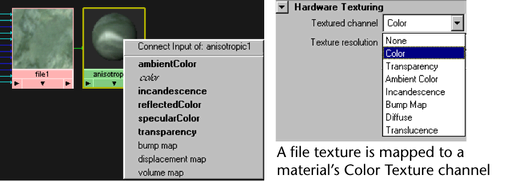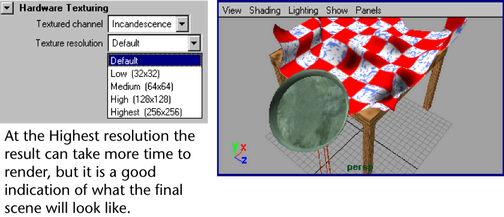Show in Contents

Add to Favorites

Home: Autodesk Maya Online Help

Hardware Render Buffer

Hardware Render Buffer

Hardware Render Buffer global settings

Hardware Render Buffer window
NoteThe Hardware renderer, with its greater
capabilities, is now recommended to perform hardware rendering.
See
Maya Hardware renderer.
The Hardware Render Buffer lets
you render an animation using your computer’s display graphics card.
Hardware rendering is much faster than software rendering, although
the result may be of lower quality. You can use the Hardware
Render Buffer to preview animations, or to render specific
types of particle effects.
Render Sequence will not render
particles successfully if the Render Passes and
“Motion Blur” options (found
in the Multi-Pass Render Options section of
the Hardware Render Buffer Attribute section)
are equivalent integers. For example, if Render Passes is
set to 3 and Motion Blur is set to 3, hardware
particle rendering will not work.
Set them to non-equivalent values or to use
the Disk Cache option (Solvers
> Create Particle Disk Cache).
NoteWhen the overscan attribute of the camera
is anything other than 1.0, image planes are positioned incorrectly
in the hardware render buffer (as can be seen compared to the correct
placement in software rendering).
To work around this limitation, temporarily
set the overscan to 1.0 when hardware buffer rendering.
To
open the Hardware Render Buffer
- Select
Window > Rendering Editors > Hardware Render Buffer.
Note On Mac OS X, the Hardware Render Buffer does
not open in a panel; the panel is blank when you select it.
To
set options for the Hardware Render Buffer
- In
the Hardware Render Buffer, click Render
> Attributes. For a description of the options, see
Hardware Render Buffer menus.
ImportantThe Hardware Render Buffer renders
images based on your monitor’s display (using screen captures).
Before rendering from the Hardware Render Buffer,
make sure the Hardware Render Buffer fits
on your monitor, make sure no other window overlaps the Hardware
Render Buffer, and disable your computer’s screen saver.
To
determine hardware rendering quality
- In
the Shading menu in the view panel,
make sure Smooth Shade All and Hardware
Texturing are selected.
- In
Hypershade, double-click the material swatch you want to preview
to open its Attribute Editor.
- In the Hardware Texturing section
of the material’s Attribute Editor, the Textured channel
menu contains the attributes you can hardware render. Select the Textured channel
you want to view from the menu.
Note
- You
can only view one channel at a time.
- To
view an attribute, it must be mapped to a texture. Attributes that
are not mapped are dimmed.
- Some
channels, such as Bump Map, do not provide hardware
textured results. You must use Render View to
see the results.
- Select the resolution you want from
the Texture resolution menu.
Use the flipbook
(Linux and Windows only)
The Flipbook lets
you play back a rendered sequence of images. The sequence is displayed
using the fcheck utility.
To
play back a rendered sequence of images
- Select
the sequence from the Flipbooks menu.
The sequence is displayed using the Fcheck utility.

